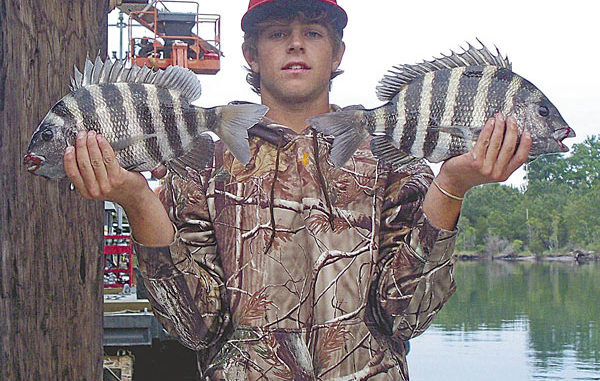
Snow’s Cut is premier sheepshead spot for North Carolina inshore anglers
Jeff Wolfe smiled as he slowly motored the quarter-mile from the boat ramp at Snow’s Cut below US 421 to the supports of the bridge spanning the waterway.
Wolfe almost always smiles, especially when he’s fishing, because as a 49-year-old long-time resident, current guide and former commercial fisherman, he knows nearly all the hot spots in the greater Wilmington area.
“I hope we’re early enough to get on my favorite spot at the bridge,” he said. “But we do have the tide in our favor.”
The incoming tide — pulled through Carolina Beach Inlet, then Myrtle Grove Sound, then into the Cape Fear River — was flowing at a slow pace.
“That’s when you need to fish here,” he said, “the first or last two hours of slack tide, otherwise, it rips through here too fast to keep baits straight.”
Keeping baits straight down beside the wooden bulkhead pilings on either side of the main channel is the key to fishing for sheepshead at Snow’s Cut.
The toothy, striped fish, which can weigh up to 20 pounds is becoming an increasingly favorite target of inshore anglers along the coast.
Besides being one of the best-tasting
denizens that live in coastal and nearshore waters, sheepshead provide plenty of sporting challenges, even though fishing for them is mainly just a factor of being there and being quick on the draw.
Fishing for these critters has other advantages. With the ever-escalating price of fuel, long boat rides aren’t usually necessary, especially at Snow’s Cut, where anglers who launch boats at the N.C. Wildlife Resources Commission ramp or Carolina Beach State Park’s marina on the southeast side of the Cut have a short jaunt to the US 421 bridge supports.
Snow’s Cut isn’t very long, wide or deep, but the man-made canal is almost always a place where some kind of saltwater fishing is hot.
Even though the shoreline features easy access and a lot of bank anglers utilize it, sheepshead anglers really need a boat. Uncounted tons of lead sinkers lie on the bottom of the cut, especially underneath the bridge, because it’s filled with snaggy stumps.
“My son, Christian, and I usually come here when I go sheepshead fishing,” said Wolfe, who owns Seahawk Inshore Charters (910-619-9580). “I don’t usually take many people sheepshead fishing because they’d rather catch red drum or speckled trout. We come here when we want some good-tasting fish to eat.”
In addition, while most inshore saltwater species have a creel limit, the sky’s the limit with sheepshead.
Anglers may keep only one red drum inside an 18- to 27-inch; spotted sea trout limits today are six fish per day — only two longer than 24 inches — and the flounder minimum size was bumped to 15 inches this year and six fish per day.
But there’s no size or creel limits for sheepshead.
So if the netters have wiped out legal-size flounder, you’ve caught your one legal-size red drum for the day or you can’t find enough speckled trout for a meal, try sheepshead.
All one needs is access to a piling or rocks encrusted by barnacles in medium-depth water. Sheepshead feed mainly on barnacles that attach themselves to wood or rocks because their version of filet mignon — fiddler crabs — isn’t that available.
“The first thing I do before I go fishing for sheepshead is catch a bunch of fiddler crabs,” Wolfe said.
Fiddler crabs — aka “one-armed bandits” — aren’t the only baits that will catch sheepshead. Some people like sand fleas (mole crabs) while others prefer the small mud crabs often found living among oyster rocks. Clams also make good sheepshead bait, and anglers can either buy them or gather them with clam rakes. Meanwhile, some pier anglers actually prefer barnacles, which is understandable because sheepshead often can be seen circling pier pilings, feeding on these animals that attach themselves to the pilings.
“I like fiddler crabs because they’re easy to catch; they’ll last all day; and all you need is a bucket to put them in,” Wolfe said.
Fiddler crabs live in marsh grass.
“You can run them out of marsh grass and just round ’em up,” Wolfe said. “But I’ve got a neighbor who has a bulkhead and I run them out of the marsh grass onto his bulkhead, and they’ll hide in the cracks. It’s pretty easy to just pick them up that way out of the cracks.”
In order to avoid pinched fingers, some people use bait-tank minnow nets to capture fiddler crabs, but a fine-mesh cast net will work as well and may catch a load of the creatures at one throw.
The main thing to watch out for with a fiddler crab is the large pincer arm of the male crab. It can give a nasty pinch and has been known to draw blood. The best way to pick up a fiddler crab before inserting a hook is to depress its long arm against its body then thread the hook between its two sections of carapace.
“I’ve used hermit crabs at times for sheepshead, too, but sheepshead seem to like fiddler crabs best,” Wolfe said.
When he pulled up to the wooden baffles on the south side of the Snow’s Cut bridge, another boat with four anglers already was tied to the wooden slats. They’d beaten us by just a few minutes.
“You can catch sheepshead at either side of the bridge, but where (the other boat was) at usually has the best action,” said Wolfe, who guided his 21-foot Kenner to the southwest corner of the bulkhead and used a rope to secure the boat’s cleat to the structure.
“The only thing you have to worry about under here is boats running through the main channel at high speed or the wakes of big boats,” Wolfe said. “That’s when you have to hang on to something because it gets bumpy when big wakes bounce through.”
Tackle for sheepshead is critical because the habitat these fish enjoy is filled with razor-sharp items, including barnacles, so regular monofilament will sever easily and anglers will lose as many fish as they catch. And with a heavy fish, you’ll need line strong enough to turn a sheepshead’s face toward the surface so he can’t wrap your line around a piling or other underwater detritus.
Wolfe likes a 6½-foot, medium-heavy action Key Largo rod fitted with a Shimano Stradic 4000 reel. Baitcasters or spinning reels will work equally well since fishing for sheepshead at the bridge’s pilings is mainly a matter of just lowering bait to the bottom and developing a hair-trigger response to a bite. Precise casting isn’t a requirement.
The key tackle factor is fishing line. It has to be tough and durable yet possess a modicum of invisibility to withstand wear and tear against metal fittings and barnacles.
“I like 30-pound-test Berkley Power Pro braid, then I thread a 3-foot piece of 40-pound fluorocarbon leader through the barrel weight, tie on a swivel, then tie on the hook at the leader’s end,” Wolfe said. “It’s basically a Carolina rig.”
However, other rigs may work as well, including a drop-shot setup with one or two “dropper” lines and hooks tied above the weight and extending out about six inches from the lead line.
Braid obviously is tougher than regular monofilament, while the fluorocarbon is invisible in the water in addition to having the durability to withstand encounters with below-the-water line obstacles.
“For hooks, I like 1/0 VMC triple barbs,” he said. “My sinkers will be one or two ounces, depending on how fast the tide’s running.”
To properly impale a fiddler crab, insert the hook horizontally between its top and bottom shells near its rear.
Now comes the tricky part — detecting a strike.
As a sheepshead has rows of square, sheep-like teeth inside its mouth, it’s able to nip barnacles off pilings. The fish crushes the barnacle by grinding its inner teeth and spits out shell pieces, then it swallows the barnacle’s body.
Because fiddler crabs have much more delicate outer coverings, a sheepshead can demolish a crab’s shell so softly a bite is almost undetectable. Anglers most often will see their line twitch or feel a tiny, almost imperceptible thump of the bait.
That’s when a short wrist snap will hook a sheepshead. Forget a bass angler’s rearing jerk; it takes too long, and by the time the rod tip has moved three feet, the sheepshead will have spit the hook, which probably feels like a piece of shell.
“I’ll also look for the line moving in the opposite direction from the tide flow,” Wolfe said. “You know here (at Snow’s Cut) that’s not going to happen unless a fish has your bait.
“My main technique is to keep my rod tip close to the water, and when I feel a nibble, give it a quick little snap. It’s a snatch, not a big hookset. You have about a half-second between feeling the fish and setting the hook, so you’ve gotta pay attention all the time.”
Some sheepshead experts advise dropping bait to the bottom beside a piling then slowly winding it toward the surface until it enters a sheepshead’s strike zone. They say these fish prefer to work at a certain depth. However, I found that isn’t necessarily true.
Probably because the bulkhead pilings at Snow’s Cut are so close together, after about a dozen unsuccessful bait drops (no strikes), I simply put my baitcaster in free spool, allowed the weight to take my crab to the bottom, engaged the reel and bounced my crab from one piling to another.
This technique brought immediate strikes and, at one point, I hooked five straight sheepshead.
These fish apparently move from one piling to another and are always in transit.
When the bite slows, Wolfe often uses a hoe-like utensil to scrap barnacles from pilings. Barnacle pieces floating down creates a chum line and usually re-triggers the bite.
“The (Snow’s Cut) bridge has some decent-size fish,” Wolfe said. “My best one here is about 12 pounds. But you can catch bigger ones at the (ocean) piers. They seem to grow bigger in the ocean for some reason. Of course, you can’t tie up to a pier with a boat and fish.”
Wolfe accounted a “good day” at Snow’s Cut as 10 to 12 sheepshead.
“Fishing for them is a challenge,” he said. “These fish have saved some trips for me, but the best thing about sheepshead is they are really good eatin’.”

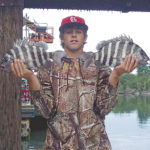
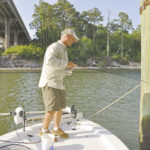
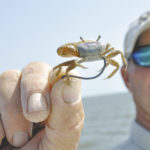
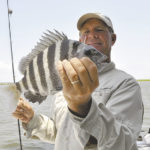
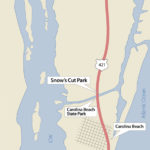




Be the first to comment